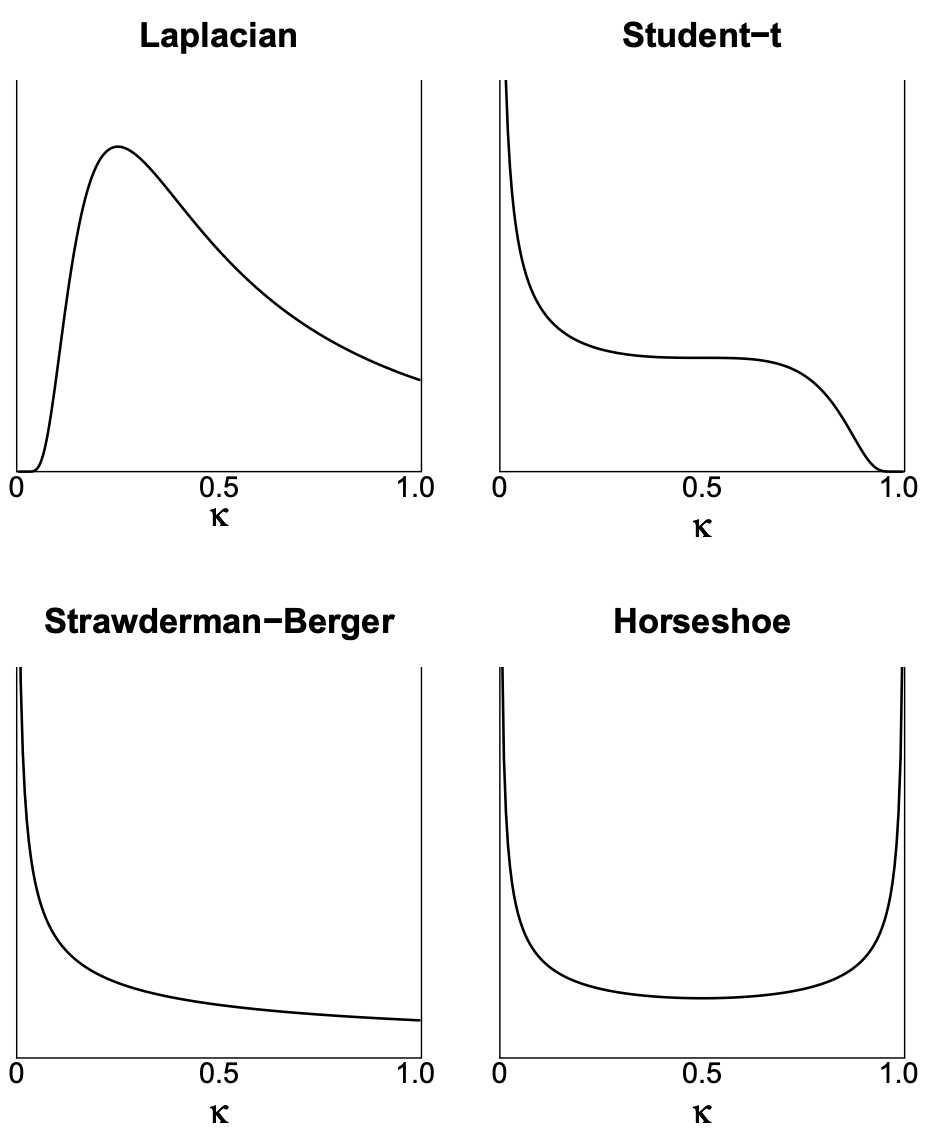Regularization
Feb 13, 2025
Review of last lecture
On Tuesday, we learned about robust regression.
Heteroskedasticity
Heavy-tailed distributions
Median regression
These were all models for the observed data
Today, we will focus on prior specifications for
Sparsity in regression problems
Supervised learning can be cast as the problem of estimating a set of coefficients
This is a central focus of statistics and machine learning.
Challenges arise in “large-
Finding a sparse solution, where some
Bayesian sparse estimation
From a Bayesian-learning perspective, there are two main sparse-estimation alternatives: discrete mixtures and shrinkage priors.
Discrete mixtures have been very popular, with the spike-and-slab prior being the gold standard.
- Easy to force
- Easy to force
Shrinkage priors force
- In recent years, shrinkage priors have become dominant in Bayesian sparsity priors.
Global-local shrinkage
Let’s assume
Sparsity can be induced into
The degree of sparsity depends on the choice of
Spike-and-slab prior
- Discrete parameter specification,
The number of zeros is dictated by
Discrete parameters can not be specified in Stan!
Spike-and-slab prior
- Spike-and-slab can be written generally as a two-component mixture of Gaussians,
Often
Ridge regression
Ridge regression is motivated by extending linear regression to the setting where:
there are too many predictors (sparsity is desired) and/or,
The OLS estimate becomes unstable:
Ridge regression
The ridge estimator minimizes the penalized sum of squares,
- Adding the
- Adding the
Bayesian ridge prior
Ridge regression can be obtained using the following global-local shrinkage prior,
This is equivalent to:
How is this equivalent to ridge regression?
Bayesian ridge prior
- The negative log-posterior is proportional to,
The posterior mean and mode are
Since
Bayesian statistics is inherently performing regularization!
Lasso regression
The least absolute shrinkage and selection operator (lasso) estimator minimizes the penalized sum of squares,
Lasso is desirable because it can set some
Bayesian lasso prior
Lasso regression can be obtained using the following global-local shrinkage prior,
This is equivalent to:
How is this equivalent to lasso regression?
Bayesian lasso prior
- The negative log-posterior is proportional to,
Lasso is recovered by specifying:
The posterior mode is
As
Bayesian lasso does not work
There is a consensus that the Bayesian lasso does not work well.
It does not yield
The gold-standard sparsity-inducing prior in Bayesian statistics is the horseshoe prior.
Relevance vector machine
Before we get to the horseshoe, one more global-local prior, called the relevance vector machine.
This model can be obtained using the following prior,
- This is equivalent to:
Horseshoe prior
The horseshoe prior is specified as,
Half-Cauchy distribution
A random variable
- The Half-Cauchy distribution with
Half-Cauchy distribution in Stan
In Stan, the half-Cauchy distribution can be specified by putting a constraint on the parameter definition.
Half-Cauchy distribution

Horseshoe prior
The horseshoe prior has two interesting features that make it particularly useful as a shrinkage prior for sparse problems.
It has flat, Cauchy-like tails that allow strong signals to remain large (that is, un-shrunk) a posteriori.
It has an infinitely tall spike at the origin that provides severe shrinkage for the zero elements of
As we will see, these are key elements that make the horseshoe an attractive choice for handling sparse vectors.
Relation to other shrinkage priors
Horsehoe density

Shrinkage of each prior
Define the posterior mean of
The following relationship holds:
Standardization of predictors
In regularization problems, predictors are standardized (to mean zero and standard deviation one).
This means that so that
Shrinkage parameter:
Shrinkage parameter

Horseshoe shrinkage parameter
Choosing
This horseshoe-shaped shrinkage profile expects to see two things a priori:
Strong signals (
Zeros (
Similarity to spike-and-slab
A horseshoe prior can be considered as a continuous approximation to the spike-and-slab prior.
The spike-and-slab places a discrete probability mass at exactly zero (the “spike”) and a separate distribution around non-zero values (the “slab”).
The horseshoe prior smoothly approximates this behavior with a very concentrated distribution near zero.

Choosing a prior for
Carvalho et al. 2009 suggest
Polson and Scott 2011 recommend
Another prior comes from a quantity called the effective number of nonzero coefficients,
Global shrinkage parameter
- The prior mean can be shown to be,
- Setting
Global shrinkage parameter

Non-Gaussian observation models
- The reference value:
This framework can be applied to non-Gaussian observation data models using plug-in estimates values for
Gaussian approximations to the likelihood.
For example: For logistic regression
Coding up the model in Stan
Horseshoe model has the following form,
Efficient parameter transformation,
Horseshoe in Stan
data {
int<lower = 1> n;
int<lower = 1> p;
vector[n] Y;
matrix[n, p] X;
real<lower = 0> tau0;
}
parameters {
real alpha;
real<lower = 0> sigma;
vector[p] z;
vector<lower = 0>[p] lambda;
real<lower = 0> tau;
}
transformed parameters {
vector[p] beta;
beta = tau * lambda .* z;
}
model {
// likelihood
target += normal_lpdf(Y | alpha + X * beta, sigma);
// population parameters
target += normal_lpdf(alpha | 0, 3);
target += normal_lpdf(sigma | 0, 3);
// horseshoe prior
target += std_normal_lpdf(z);
target += cauchy_lpdf(lambda | 0, 1);
target += cauchy_lpdf(tau | 0, tau0);
}Prepare for next class
Work on HW 03, which was just assigned.
Complete reading to prepare for next Tuesday’s lecture
Tuesday’s lecture: Classification

